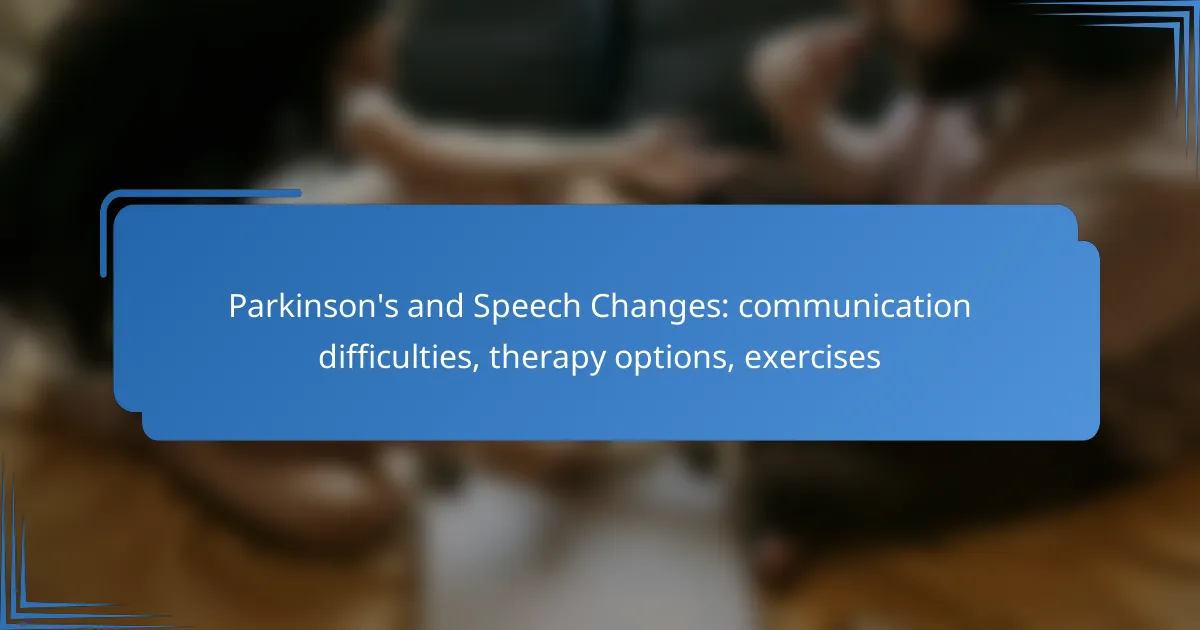Parkinson’s disease can lead to significant communication difficulties, affecting speech clarity, volume, and articulation, which in turn impacts social interactions and overall quality of life. Fortunately, various therapy options and targeted exercises are available to help individuals improve their communication skills, enhance vocal strength, and regain confidence in expressing themselves.
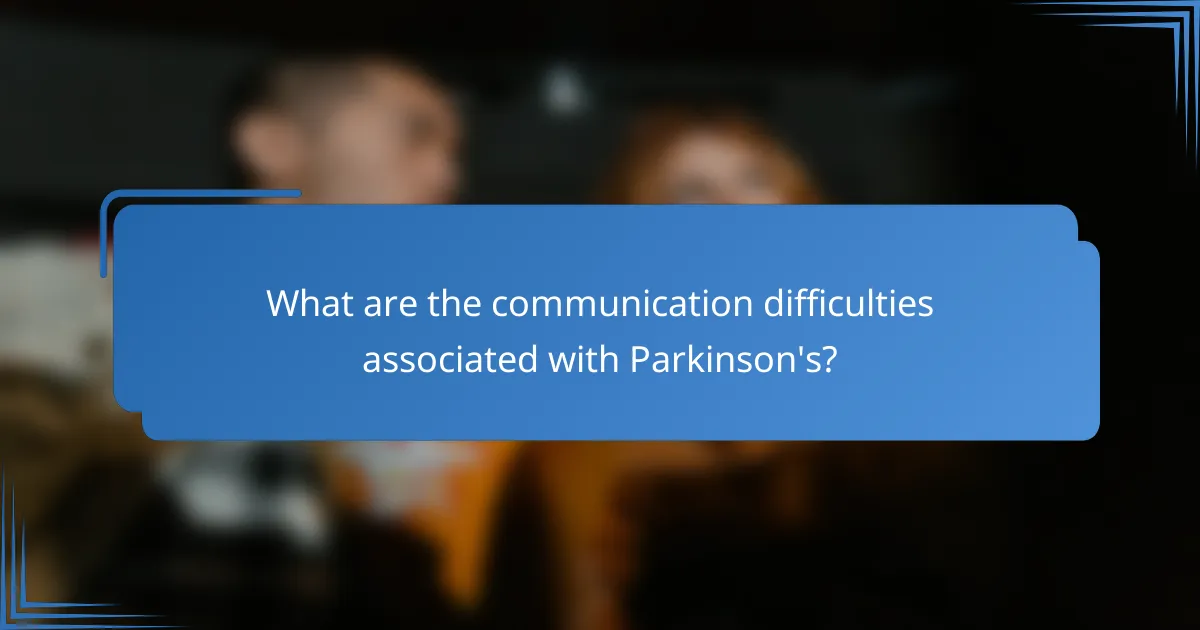
What are the communication difficulties associated with Parkinson’s?
Individuals with Parkinson’s disease often experience various communication difficulties that can significantly impact their social interactions and quality of life. These challenges include issues with speech clarity, volume control, articulation, pitch, and non-verbal communication.
Speech clarity issues
Speech clarity issues in Parkinson’s patients can manifest as slurred or mumbled speech, making it difficult for others to understand them. This can occur due to muscle rigidity and reduced control over the vocal cords and mouth muscles.
To improve clarity, speech therapy techniques such as articulation exercises and slow, deliberate speech practice can be beneficial. Regular practice can help reinforce muscle memory and enhance communication effectiveness.
Volume control challenges
Many individuals with Parkinson’s struggle with volume control, often speaking too softly or too loudly. This inconsistency can lead to frustration in conversations and may require others to strain to hear them.
Therapists often recommend vocal exercises that focus on projecting the voice and maintaining a consistent volume. Using visual or auditory feedback tools can also help individuals become more aware of their speaking volume.
Articulation problems
Articulation problems involve difficulty pronouncing words clearly, which can lead to misunderstandings. This is often due to weakened facial muscles and impaired coordination.
Practicing specific sounds and syllables can aid in improving articulation. Techniques like reading aloud or using tongue twisters can serve as effective exercises to enhance clarity and precision in speech.
Changes in pitch
Changes in pitch can occur in Parkinson’s patients, leading to a monotone voice or an inability to modulate pitch effectively. This can make speech sound flat and less engaging.
Voice training exercises that focus on varying pitch can help individuals regain some control over their vocal range. Engaging in singing or reading poetry aloud can also encourage pitch variation and improve expressiveness.
Non-verbal communication impacts
Non-verbal communication, such as facial expressions and gestures, may diminish in individuals with Parkinson’s, leading to a less expressive demeanor. This can affect how emotions and intentions are conveyed in social interactions.
To enhance non-verbal communication, individuals can practice using facial expressions in front of a mirror or engage in role-playing exercises. Incorporating gestures while speaking can also help convey messages more effectively, making interactions more meaningful.
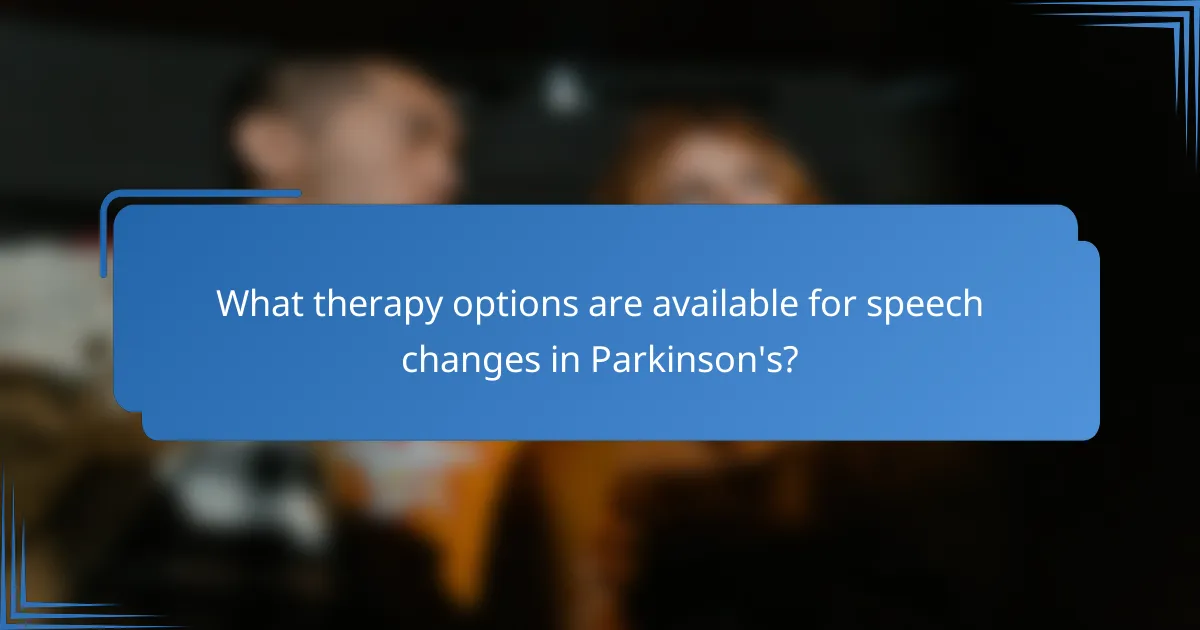
What therapy options are available for speech changes in Parkinson’s?
Several therapy options exist to address speech changes in individuals with Parkinson’s disease. These therapies focus on improving communication skills, enhancing vocal strength, and providing support through various methods tailored to individual needs.
Speech therapy techniques
Speech therapy techniques for Parkinson’s often include exercises aimed at improving articulation, breath control, and vocal intensity. Therapists may use strategies such as vocal warm-ups, pitch exercises, and resonance training to help patients regain clarity in their speech.
Patients are encouraged to practice these techniques regularly, as consistency is key to seeing improvement. Simple exercises can be integrated into daily routines, making it easier to maintain progress over time.
Lee Silverman Voice Treatment (LSVT)
The Lee Silverman Voice Treatment (LSVT) is a specialized speech therapy designed for individuals with Parkinson’s. This program emphasizes loud voice production and is typically delivered in intensive sessions over a month, focusing on increasing vocal loudness and improving speech clarity.
LSVT has shown effectiveness in enhancing communication abilities, with many patients reporting significant improvements in their speech after completing the program. It is essential to work with a certified LSVT therapist to ensure proper implementation and maximize benefits.
Group therapy sessions
Group therapy sessions provide a supportive environment for individuals with Parkinson’s to practice their speech skills. These sessions often involve interactive activities, such as reading aloud or engaging in conversations, which help participants build confidence in their communication abilities.
Additionally, group settings allow for social interaction, which can be beneficial for emotional well-being. Participants can share experiences and strategies, fostering a sense of community and mutual support.
Teletherapy services
Teletherapy services offer a convenient option for individuals seeking speech therapy for Parkinson’s. Through video conferencing, patients can connect with licensed speech therapists from the comfort of their homes, making therapy more accessible.
This method can be particularly beneficial for those with mobility challenges or those living in remote areas. It is important to ensure that the chosen teletherapy platform is secure and compliant with health regulations to protect patient privacy.
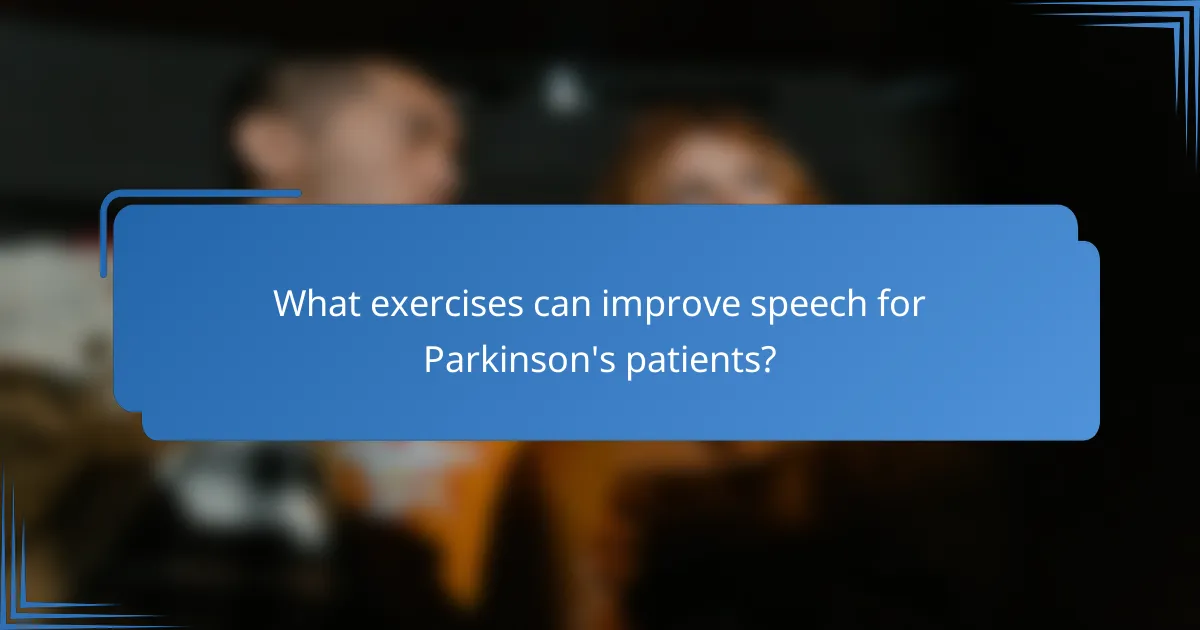
What exercises can improve speech for Parkinson’s patients?
Exercises that focus on vocal strength, breath control, and articulation can significantly enhance speech for Parkinson’s patients. These activities help address common communication difficulties by improving clarity and volume, making it easier for patients to express themselves.
Vocal exercises
Vocal exercises are designed to strengthen the voice and improve pitch control. Simple activities such as humming, singing scales, or practicing vowel sounds can be beneficial. Aim for 10-15 minutes of vocal exercises daily to build strength and confidence in speaking.
Consider using a mirror to monitor mouth movements and ensure proper technique. Recording your voice can also help track progress over time.
Breathing techniques
Breathing techniques are essential for managing breath support, which directly affects speech quality. Diaphragmatic breathing, where you breathe deeply from your abdomen rather than your chest, can enhance voice projection. Practice inhaling deeply for a count of four, holding for a count of four, and exhaling for a count of six.
Incorporate these techniques into daily routines, especially before speaking situations, to ensure better control over breath and voice during conversations.
Articulation drills
Articulation drills focus on improving clarity and precision in speech. Exercises such as repeating tongue twisters or practicing specific consonant sounds can help. Start slowly and gradually increase speed as clarity improves.
Regular practice of these drills, ideally 5-10 minutes each day, can lead to noticeable improvements in speech intelligibility and confidence in communication.
Daily practice routines
Establishing a daily practice routine is crucial for consistent improvement in speech. Set aside dedicated time each day for vocal exercises, breathing techniques, and articulation drills. A structured routine can enhance motivation and ensure comprehensive practice.
Consider using a checklist to track daily exercises and progress. Engaging family members or caregivers in practice sessions can also provide support and encouragement, making the process more enjoyable.
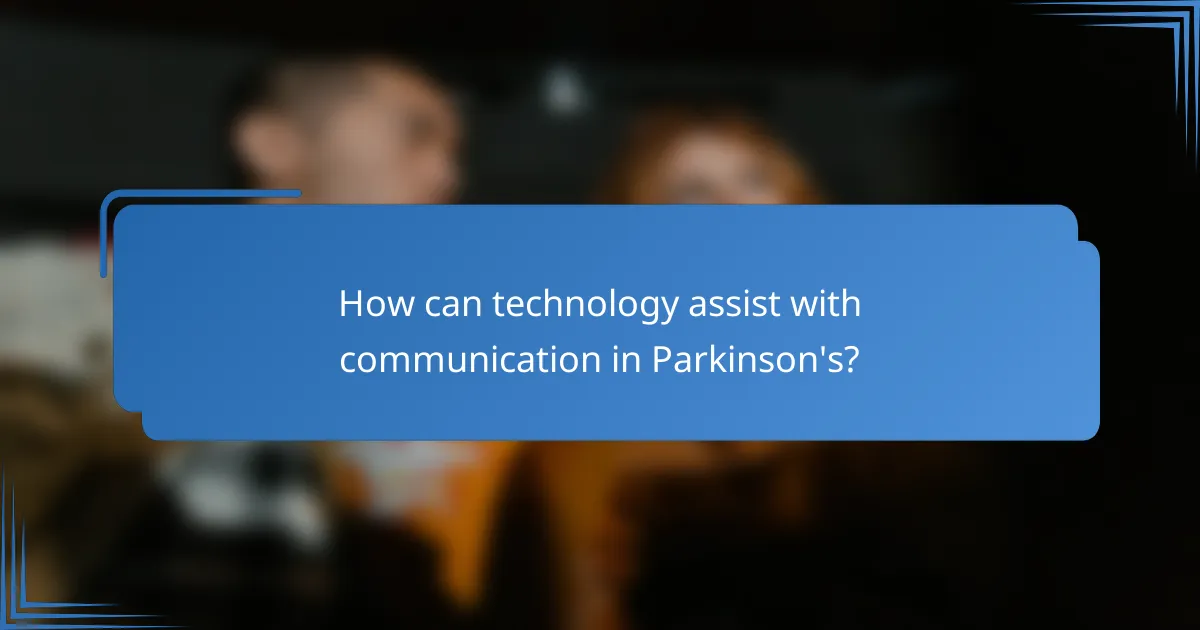
How can technology assist with communication in Parkinson’s?
Technology can significantly enhance communication for individuals with Parkinson’s by providing tools that address speech difficulties. These tools range from specialized devices to mobile applications that help users practice and improve their speech clarity.
Speech-generating devices
Speech-generating devices (SGDs) are electronic tools that convert text or symbols into spoken words. They are particularly beneficial for those with severe speech impairments, allowing users to communicate effectively by selecting phrases or typing messages. Many SGDs are portable and can be customized to meet individual needs.
When considering an SGD, look for features such as touch screens, voice options, and compatibility with other devices. Some popular models include the Tobii Dynavox and the Accent series, which offer various functionalities to suit different user preferences.
Mobile apps for speech practice
Mobile applications designed for speech practice can help individuals with Parkinson’s improve their vocal skills through interactive exercises. These apps often include features such as voice recording, feedback on speech clarity, and tailored practice routines. Examples include apps like Speech Assistant and Voice4u.
To maximize benefits, users should select apps that offer personalized feedback and track progress over time. Regular practice using these apps can lead to noticeable improvements in speech confidence and clarity.
Voice amplification tools
Voice amplification tools are devices that enhance the volume of a person’s voice, making it easier for others to hear them. These tools can range from handheld amplifiers to wearable microphones, and they are particularly useful in noisy environments or for individuals who struggle to project their voice.
When choosing a voice amplification tool, consider factors such as battery life, portability, and ease of use. Options like the Pocket Talker or personal amplifiers can provide significant assistance in everyday conversations, helping users communicate more effectively without straining their vocal cords.
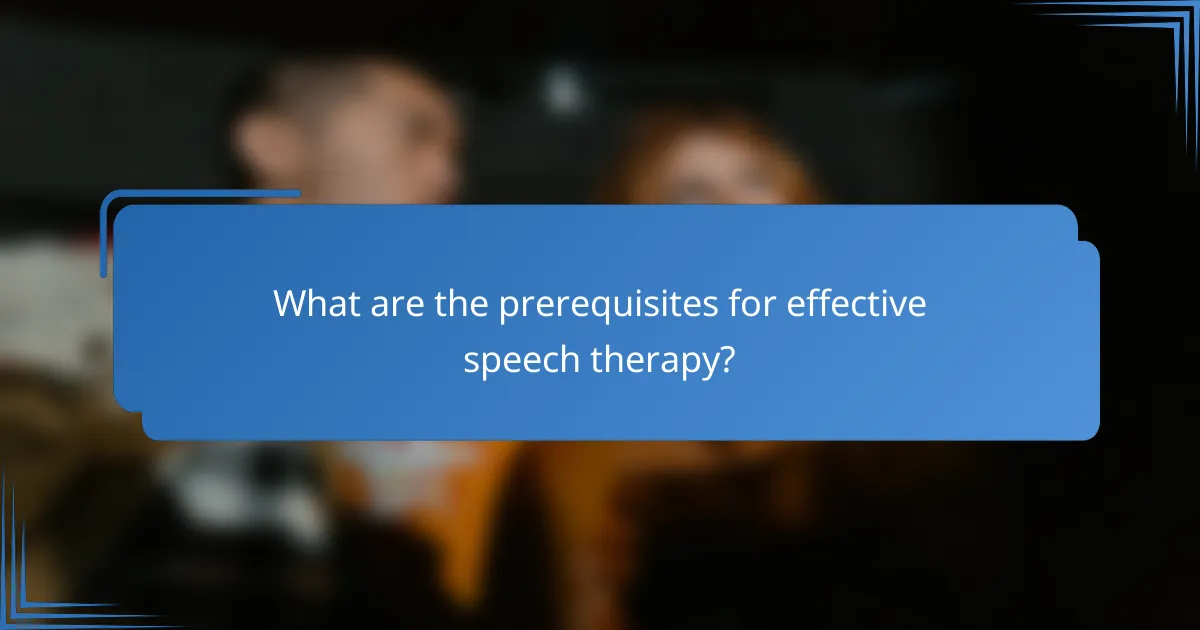
What are the prerequisites for effective speech therapy?
Effective speech therapy for individuals with Parkinson’s requires a comprehensive assessment and tailored goals. Understanding the specific communication difficulties and personal needs of the patient is essential for developing an effective therapy plan.
Assessment by a speech-language pathologist
An initial assessment by a speech-language pathologist (SLP) is crucial for identifying the specific speech and communication challenges faced by individuals with Parkinson’s. This evaluation typically includes standardized tests, observational assessments, and interviews to gather information about the patient’s speech patterns, voice quality, and overall communication abilities.
During the assessment, the SLP may also evaluate the patient’s cognitive-communication skills, which can impact their ability to express themselves. This thorough understanding allows the SLP to create a targeted therapy plan that addresses the unique needs of the individual.
Personalized therapy goals
Setting personalized therapy goals is essential for effective speech therapy. These goals should be specific, measurable, achievable, relevant, and time-bound (SMART), focusing on improving areas such as articulation, volume, and clarity of speech. For example, a goal might involve increasing vocal volume by a certain percentage within a few weeks.
Regularly reviewing and adjusting these goals based on the patient’s progress is important. This ensures that the therapy remains relevant and effective, addressing any new challenges that may arise as the condition progresses. Collaboration between the patient, their family, and the SLP can enhance motivation and adherence to the therapy plan.
